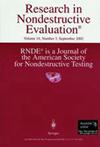基于几何局部自适应锐化的飞机结构材料数字射线图像缺陷检测
IF 1.6
4区 材料科学
Q3 MATERIALS SCIENCE, CHARACTERIZATION & TESTING
引用次数: 4
摘要
飞机的寿命取决于其结构腐蚀的早期发现和清除。检测腐蚀的重要性不能被低估,因为腐蚀会导致其他类型的损害,如裂缝。射线照相是检测飞机结构隐藏缺陷的一种重要方法。为了最大限度地从射线成像图像中提取信息,需要通过不同的方法将系统的噪声最小化,或将缺陷区域的对比度最大化。在空间和频域内开发有效的图像处理方法对工业射线照相检测的研究至关重要。在本研究中,采用几何局部自适应锐化方法来改善飞机零件射线照片中隐藏结构细节和缺陷的可视化。该方法采用转向核回归方法进行锐化。在这里,增强对比度和锐化算法有效地混合在一起。该算法成功地应用于飞机零件的射线成像图像。通过锐化边缘和保留精细图像信息,提高了图像的结构细节可视化和缺陷区域检测能力。专家评价表明,几何局部自适应锐化重建图像的缺陷区域比原始图像具有更好的可视化效果。此外,对输出图像的结果评估表明,该方法使图像的边缘被锐化,并且图像的背景减小到零。本文章由计算机程序翻译,如有差异,请以英文原文为准。
Defects Detection of Digital Radiographic Images of Aircraft Structure Materials via Geometric Locally Adaptive Sharpening
ABSTRACT The life of an aircraft depends on the early detection and removal of corrosion in its structure. The importance of detecting corrosion cannot be understated, because corrosion can cause other kinds of damage, such as cracks. Radiography is an important method for the detection of hidden defects in aircraft structure. To maximize information extraction from the radiographic images, the noise of the system should be minimized, or the contrast of the defective region should be maximized by different methods. The development of effective image processing methods, within both the spatial and frequency domains, is important to the research of industrial radiographic testing. In this study, the geometric locally adaptive sharpening method was used to improve hidden structure visualization of details and defects from aircraft part radiographs. The method relies on sharpening by using the steering kernel regression method. Here, the enhancing contrast and sharpening algorithm are effectively mixed together. The proposed algorithm was successfully applied to radiographic images of aircraft parts. An improvement of the structure detail visualization and defect region detection was achieved by sharpening the edges and preserving fine detail imaging information. Experts’ reviews showed that defect regions from the geometric locally adaptive sharpening reconstructed images were better visualized than the original images. Also, the resulting evaluation of the output images shows that the edges are sharpened by the proposed method and that the background of the image decreases to zero.
求助全文
通过发布文献求助,成功后即可免费获取论文全文。
去求助
来源期刊

Research in Nondestructive Evaluation
工程技术-材料科学:表征与测试
CiteScore
2.30
自引率
0.00%
发文量
14
审稿时长
>12 weeks
期刊介绍:
Research in Nondestructive Evaluation® is the archival research journal of the American Society for Nondestructive Testing, Inc. RNDE® contains the results of original research in all areas of nondestructive evaluation (NDE). The journal covers experimental and theoretical investigations dealing with the scientific and engineering bases of NDE, its measurement and methodology, and a wide range of applications to materials and structures that relate to the entire life cycle, from manufacture to use and retirement.
Illustrative topics include advances in the underlying science of acoustic, thermal, electrical, magnetic, optical and ionizing radiation techniques and their applications to NDE problems. These problems include the nondestructive characterization of a wide variety of material properties and their degradation in service, nonintrusive sensors for monitoring manufacturing and materials processes, new techniques and combinations of techniques for detecting and characterizing hidden discontinuities and distributed damage in materials, standardization concepts and quantitative approaches for advanced NDE techniques, and long-term continuous monitoring of structures and assemblies. Of particular interest is research which elucidates how to evaluate the effects of imperfect material condition, as quantified by nondestructive measurement, on the functional performance.
 求助内容:
求助内容: 应助结果提醒方式:
应助结果提醒方式:


